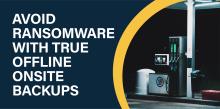
United States Commerce Secretary Gina Raimondo recently announced that ransomware attacks "are here to stay."
Yeah, we know. That's why we've told anyone who will listen that organizations need offline backups of their systems and data using a superior, industrial, and programmable USB hub. Rotating offline onsite backups will save your backside in today’s cyberattack-happy world.
Here are the top six reasons why:
1. Ransomware can cripple your entire enterprise
Ransomware is malware on (crypto) steroids. It not only locks up your systems and data, but it encrypts and blocks everything until you pay a ransom. Ransomware is intractable, difficult to trace, and nearly impossible to get around.
Solution: Automatic backups using an industrial and programmable 8-port USBHub3+. Program the USBHub to turn on a single port (with a USB storage device attached) at set intervals.
2. Ransomware is an asymmetric attack
Ransomware attacks are carried out in two ways: 1) A Trojan file sent by email that’s downloaded or opened; and 2) a vulnerability in your network. It doesn’t take long for the attackers to cripple your company, and sometimes days or weeks for your company to recover.
Solution: Rotate the backups. The USBHub3+ has eight ports. Create Monday-Sunday daily snapshots using ports 0-7, and use the 8th port to backup full weekly images.
3. Ransomware can cost you big money
The global average cost of a ransomware attack is $761,106 (including downtime, people time, device cost, network cost, lost opportunities, and ransom paid.)
Solution: The Acroname USBHub3+ only costs $545.
4. Always-on cloud backups aren’t enough
Cloud-based backups are not immune from ransomware. The cloud can also be hacked, and then you have data-theft on top of ransom to deal with. Plus, an “always-on” cloud backup may sync the corrupted files and overwrite the good files. Now both the local and cloud backups are corrupted.
Solution: Offline backup.
5. Mobile Operating Systems (like Android) are not immune
Ransomware also targets mobile operating systems where applications can be installed by third-party sources (we’re looking at you, Android).
Solution: The USBHub3+ is designed to physically separate backup media from the host system.
6. Ransomware can attack faster than your anti-virus can defend
Attackers attack while your antivirus software reacts. The attackers see vulnerabilities you don’t see and you will always be on the defensive. Always.
Solution: When you’re attacked (and you’ll be attacked), your automatic, programmed, and reliable offline backup ensures that you’re only one day, instead of months or years, behind.
Get true offline backs without the headache of manually unplugging/replugging devices constantly
Acroname Programmable Industrial USB 3.0 Hub: Having an offline backup helps you recover quickly from ransomware. Here’s how it works: Program the hub to turn on a single port (with a USB storage device attached) at set intervals. Meanwhile, ensure all other ports are disabled. This is virtually identical to physically plugging/unplugging devices from your system. But it can be done automatically.
Full details on how this works can be found here. We bet that the people in the Southeast U.S. a few weeks back wished that the pipeline company had backed up their data.
That is far better than paying hundreds of thousands in BTC to Russian hackers -- or apologizing to your neighbors for the gas shortage and price gouging.
Add New Comment